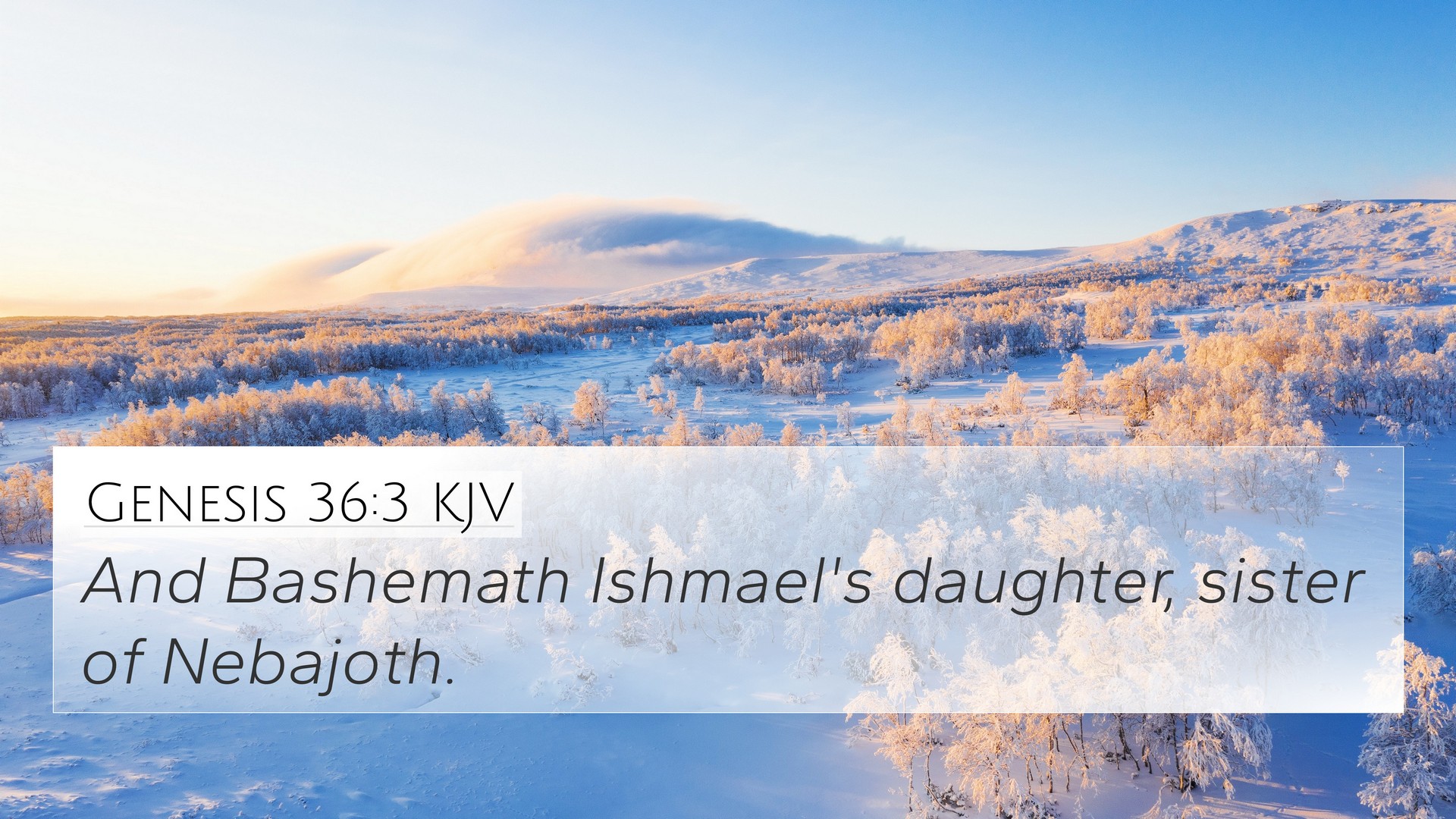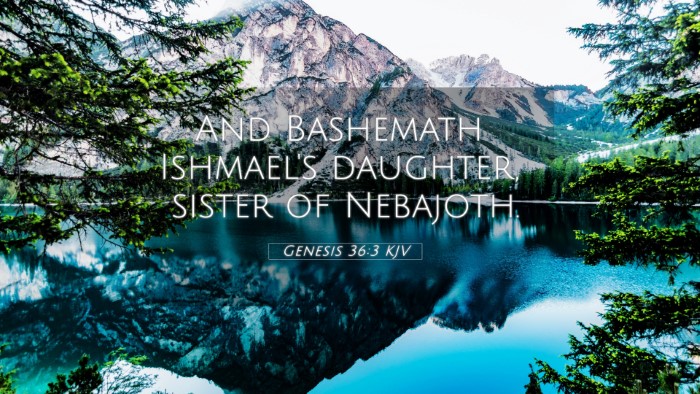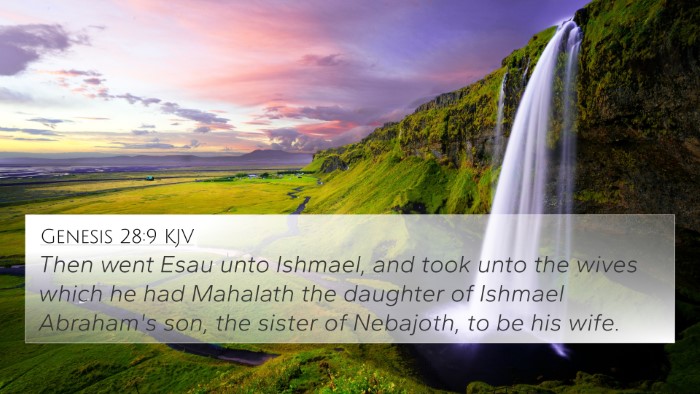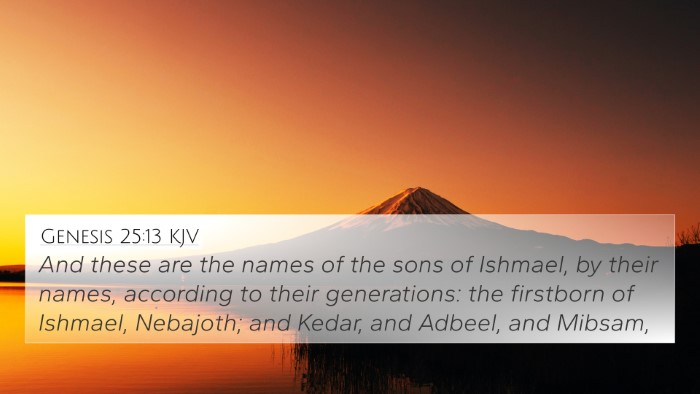Understanding Genesis 36:3
Genesis 36:3 states, "And Bashemath, Ishmael's daughter, sister of Nebajoth, bore unto Esau." This verse is notable for its implications concerning lineage and relationships in the context of the descendants of Esau, the brother of Jacob. Below is a synthesis of insights derived from several public domain commentaries.
Key Insights from Commentaries
Matthew Henry: Henry emphasizes the significance of Bashemath's lineage. Being the daughter of Ishmael connects Esau to the line of Abraham, which showcases the importance of genealogies in Biblical narratives. This connection points to the broader theme of God’s covenant unfolding through different families.
Albert Barnes: Barnes highlights the cultural implications of this marriage. The union between Esau and the family of Ishmael demonstrates a blending of different lineages, which can be seen as a foretaste of the complexities that arise in familial relationships throughout scripture.
Adam Clarke: Clarke notes that the name "Bashemath" means "fragrant," which could imply a favorable association. The naming presents an intriguing exploration of how names carry significance and reflect the character or the circumstances of individuals in the biblical narrative.
Cross-References and Connections
Genesis 36:3 is enriched by numerous related verses that help illustrate its themes and connections:
- Genesis 25:12-18: The genealogy of Ishmael establishes the heritage of Esau's wife.
- Genesis 28:9: Esau's marriage to a daughter of Ishmael further connects him to Abraham's family.
- Genesis 36:1: This verse identifies Esau and emphasizes his lineage.
- Genesis 24:3: The importance of marrying within the family is echoed in Abraham's instruction to Isaac's servant.
- Genesis 27:46: Rebekah's concern about Esau’s wives reflects broader themes of family and relationships.
- Jeremiah 49:10: The descendants of Esau are still relevant in prophetic literature.
- Hebrews 12:16: Esau is mentioned in the New Testament as a warning against immoral behavior.
- Malachi 1:3: The enmity between Jacob and Esau is central to God’s message regarding their descendants.
- Romans 9:13: Paul cites the relationship between Jacob and Esau to illustrate God's sovereign choices.
- 1 Chronicles 1:35-36: This genealogical record further elaborates on Esau’s descendants.
Thematic Connections
The connection between Genesis 36:3 and other scriptures can be viewed thematically. The themes of lineage, family dynamics, and God's covenantal purposes become evident as the reader considers both the Old and New Testaments. Insights into how different Biblical texts link together deepen the understanding of God's plan and the people involved.
A notable element is how many Bible verses relate to each other through genealogical lines, such as:
- Linking Abraham's covenant with Abraham's descendants.
- Comparative Bible verse analysis methods illustrate how familial tensions shape narratives.
- Inter-Biblical dialogue between genealogies in Chronicles and Genesis.
- Thematic connections are drawn through the marriages within Abraham's family and the consequences in the generations to come.
Using Cross-Referencing in Bible Study
Understanding Genesis 36:3 through cross-referencing aids in the comprehensive study of scripture. It is advisable to employ tools for Bible cross-referencing such as:
- Bible concordance
- Bible cross-reference guide
- Cross-reference Bible study techniques
- Bible reference resources for deeper insights
- Comprehensive cross-reference materials for sermon preparation
These tools help believers discern how to find cross-references in the Bible and lead to greater understanding of themes like familial duty, covenant fidelity, and divine promise.
Conclusion
Genesis 36:3 offers profound insights into the complexities of relationships in the Biblical narrative. By analyzing this verse and its connections, readers are encouraged to explore the deep interconnections between scripture, enhancing one’s spiritual understanding and appreciation for the intricate tapestry of Biblical history.
In reflecting upon these themes, one can uncover the nuances of God's covenant with His people and how the lessons learned through genealogies like that of Esau continue to speak to believers today.




